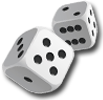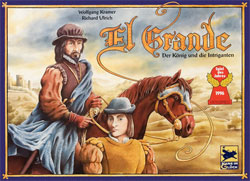



play board games
Board game reviews, strategy tips & session reports
El Grande Review
 Stats:
Stats:
No. of players: 2-5
Amount of time to play: 90 minutes
Age requirements: 12+
Set-up time: 10 min
El Grande Rules Description:
El Grande is an area control game that is very strategic, interactive and a lot of fun. The game is 9 rounds long and you score points once every 3 rounds. The player with the most points after the ninth round is over wins the game.
El Grande takes place in Spain and the map is sectioned off into ten regions. To start the game players get one random starting region, a deck of 13 Power Cards, 10 caballeros and one El Grande. You place the El Grande and 2 caballeros in the starting region. The El Grande marks your starting region. You also place one of your caballeros one the Start space of the scoring track. The King is placed in a random starting region and you are ready to begin.
On your turn you do the following things:
1) Play a Power card
2) Move Caballeros from the Provinces to the court
3) Select an Action card
4 or 5) Move Caballeros from the court to the board
5 or 4) Execute the special action on the action card you selected
The Power cards are numbered 1-13. At the beginning of each round you will play one Power card and it will be used up for the game. Players take their turn in order from highest to lowest based on the Power card you play. Once a number has been played it cannot be played again that same round.
There are three places your caballeros are kept, either in the Provinces, in your Court or on the board. Caballeros move from your Provinces to your Court based on the Power card you play. Low numbers move more (as many as six) and high numbers move as little as none.
In order to put Caballeros on the board you need to have them in your court. So there is some thinking that must go into which Power card you play. You want to play something high enough to select the action you want but if you never play a low number you’ll run out of Caballeros in your Court. Then you’ll have nothing to put on the board.
The action cards are placed on the side of the board in five piles. Each pile tells you how many Caballeros you may take from your Court and place them on the board. When placing Caballeros on the board, they must be put into a region next to the King or in the Castillo (I’ll explain this soon). They may not be placed in the King’s region. Moving the King is an action so important it allows you to place 5 Caballeros on the board. It is the only action in the 5 stack and is available every turn. Each round a different action card is turned face-up from the action pile stacks. You may place Caballeros before or after you execute the special action, but must finish that phase completely.
The different action cards allow you to remove other player’s Caballeros from the board, score specific regions and even Veto another special action. The lower the number of Caballeros you are able to put on the board the more likely you are to be able to mess with other player’s plans. The 3 and 4 stacks tend to help you while the 1 and 2 stacks tend to help you move other players pieces.
Like I said earlier you may place Caballeros in the Castillo. While not considered a region the Castillo scores you points based on the number of Caballeros you have put in it. The hard part is that you cannot see into the Castillo. Once dropped inside you must remember how many each player has placed in it. The other nice thing is that after the Caballeros in the Castillo are scored they are placed on one region of the board to help reinforce your position there. Each player has a dial that shows each region. You secretly point the dial to the region that your Caballeros will go to and all players reveal their selection at the same time.
At the end of each round the player that played the lowest Power card plays their Power card for the next round first. Then the players play their Power cards in a clock-wise order from there.
After the third, sixth and ninth rounds you score the regions. Each region has a scoring block (including the Castillo). Most scoring blocks have 3 numbers in them (a couple have 2). When you score a region the player with the most Caballeros gets the most points in the block. The player with the second most Caballeros gets the second highest number of points and the player with the third most Caballeros in the region gets the third number (if there is one). You get 2 extra points for being first in your starting region and another 2 points for being in first where the king is. Ties give both players the points in the next lowest block.
A Quick Review of El Grande:
Although El Grande is complex to explain it is fairly easy to play. And even if first time players will probably lose against more experienced ones, they will understand the game play and basic strategy quickly. El Grande has a nice blend of strategy and interaction with a bit of luck. The way the placement and movement of Caballeros works is great.
One thing to be aware of in El Grande is that the leader will tend to be ganged up on. It might even be necessary. If not you might be able to gain the lead and never be caught. Experience will usually beat new players, but after a few plays the playing field should be leveled.
El Grande is currently ranked 10th on BoardGameGeek and for good reason. It is such a nicely balanced game that is a ton of fun for anyone who enjoys strategy games.
Score and synopsis: (Click here for an explanation of these review categories.)
Strategy 5 out of 6
Luck 3 out of 6
Player Interaction 5 out of 6
Replay Value 6 out of 6
Complexity 4 out of 6
Fun 5 out of 6
Overall 6 out of 6

I’m normally a big fan of worker placement and area control games, but after one game of El Grande I’ve never wanted to play it again; I’m not sure why. It’s been about five years since I’ve played; I think it was something about the cards.
Oddly enough, I’m not sure I’ve seen this hit the table at all in my group, in the last few years.
I think you should try it again. I like El Grande a lot and wish it hit my table more.